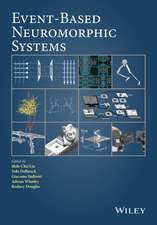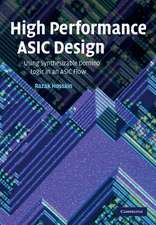Electronics System Design Techniques for Safety Critical Applications: Lecture Notes in Electrical Engineering, cartea 26
Autor Luca Sterponeen Limba Engleză Hardback – 14 oct 2008
| Toate formatele și edițiile | Preț | Express |
|---|---|---|
| Paperback (1) | 634.00 lei 6-8 săpt. | |
| SPRINGER NETHERLANDS – 23 noi 2010 | 634.00 lei 6-8 săpt. | |
| Hardback (1) | 640.06 lei 6-8 săpt. | |
| SPRINGER NETHERLANDS – 14 oct 2008 | 640.06 lei 6-8 săpt. |
Din seria Lecture Notes in Electrical Engineering
- 18%
 Preț: 1859.04 lei
Preț: 1859.04 lei - 18%
 Preț: 895.27 lei
Preț: 895.27 lei - 17%
 Preț: 397.66 lei
Preț: 397.66 lei - 18%
 Preț: 1562.17 lei
Preț: 1562.17 lei - 20%
 Preț: 1473.39 lei
Preț: 1473.39 lei - 18%
 Preț: 5169.60 lei
Preț: 5169.60 lei - 20%
 Preț: 1741.49 lei
Preț: 1741.49 lei - 20%
 Preț: 1918.04 lei
Preț: 1918.04 lei - 18%
 Preț: 1573.20 lei
Preț: 1573.20 lei - 18%
 Preț: 1851.77 lei
Preț: 1851.77 lei - 18%
 Preț: 1578.72 lei
Preț: 1578.72 lei - 18%
 Preț: 1903.08 lei
Preț: 1903.08 lei - 18%
 Preț: 2113.02 lei
Preț: 2113.02 lei - 18%
 Preț: 892.42 lei
Preț: 892.42 lei - 18%
 Preț: 1404.30 lei
Preț: 1404.30 lei - 18%
 Preț: 1133.61 lei
Preț: 1133.61 lei - 18%
 Preț: 1847.84 lei
Preț: 1847.84 lei - 18%
 Preț: 1384.56 lei
Preț: 1384.56 lei - 20%
 Preț: 1300.14 lei
Preț: 1300.14 lei - 20%
 Preț: 1174.76 lei
Preț: 1174.76 lei - 20%
 Preț: 1310.03 lei
Preț: 1310.03 lei - 18%
 Preț: 2546.29 lei
Preț: 2546.29 lei - 20%
 Preț: 1310.03 lei
Preț: 1310.03 lei - 18%
 Preț: 1676.58 lei
Preț: 1676.58 lei - 20%
 Preț: 1182.20 lei
Preț: 1182.20 lei - 18%
 Preț: 1392.46 lei
Preț: 1392.46 lei - 18%
 Preț: 1119.38 lei
Preț: 1119.38 lei - 18%
 Preț: 1678.16 lei
Preț: 1678.16 lei - 18%
 Preț: 1596.85 lei
Preț: 1596.85 lei - 18%
 Preț: 1398.00 lei
Preț: 1398.00 lei - 20%
 Preț: 1445.35 lei
Preț: 1445.35 lei - 18%
 Preț: 1244.89 lei
Preț: 1244.89 lei - 20%
 Preț: 1173.10 lei
Preț: 1173.10 lei - 18%
 Preț: 810.81 lei
Preț: 810.81 lei - 20%
 Preț: 1173.93 lei
Preț: 1173.93 lei - 20%
 Preț: 1482.47 lei
Preț: 1482.47 lei - 20%
 Preț: 1915.57 lei
Preț: 1915.57 lei - 18%
 Preț: 1387.73 lei
Preț: 1387.73 lei - 18%
 Preț: 1425.62 lei
Preț: 1425.62 lei - 20%
 Preț: 1297.67 lei
Preț: 1297.67 lei - 18%
 Preț: 1407.46 lei
Preț: 1407.46 lei - 18%
 Preț: 1667.91 lei
Preț: 1667.91 lei - 18%
 Preț: 1400.35 lei
Preț: 1400.35 lei - 18%
 Preț: 1117.03 lei
Preț: 1117.03 lei - 18%
 Preț: 1573.20 lei
Preț: 1573.20 lei - 18%
 Preț: 1405.90 lei
Preț: 1405.90 lei - 18%
 Preț: 726.37 lei
Preț: 726.37 lei - 18%
 Preț: 1405.90 lei
Preț: 1405.90 lei - 18%
 Preț: 1238.56 lei
Preț: 1238.56 lei - 18%
 Preț: 725.61 lei
Preț: 725.61 lei
Preț: 640.06 lei
Preț vechi: 753.01 lei
-15% Nou
Puncte Express: 960
Preț estimativ în valută:
122.48€ • 130.97$ • 102.12£
122.48€ • 130.97$ • 102.12£
Carte tipărită la comandă
Livrare economică 18 aprilie-02 mai
Preluare comenzi: 021 569.72.76
Specificații
ISBN-13: 9781402089787
ISBN-10: 1402089783
Pagini: 164
Ilustrații: XVI, 146 p.
Dimensiuni: 155 x 235 x 20 mm
Greutate: 0.41 kg
Ediția:2009
Editura: SPRINGER NETHERLANDS
Colecția Springer
Seria Lecture Notes in Electrical Engineering
Locul publicării:Dordrecht, Netherlands
ISBN-10: 1402089783
Pagini: 164
Ilustrații: XVI, 146 p.
Dimensiuni: 155 x 235 x 20 mm
Greutate: 0.41 kg
Ediția:2009
Editura: SPRINGER NETHERLANDS
Colecția Springer
Seria Lecture Notes in Electrical Engineering
Locul publicării:Dordrecht, Netherlands
Public țintă
ResearchCuprins
An Introduction to FPGA Devices in Radiation Environments.- Radiation Effects on SRAM-Based FPGAs.- Analytical Algorithms for Faulty Effects Analysis.- Reliability-Oriented Place and Route Algorithm.- A Novel Design Flow for Fault Tolerance SRAM-Based FPGA Systems.- Configuration System Based on Internal FPGA Decompression.- Reconfigurable Devices for the Analysis of DNA Microarray.- Reconfigurable Compute Fabric Architectures.
Notă biografică
Winner of the EDAA (European Design Automation Association) Outstanding Monograph Award in the Reconfigurable Electronics section
Textul de pe ultima copertă
Nowadays, electronic systems are increasingly used in safety critical applications compared to two decades ago. Electronic devices are being used in applications where their correct operation is vital to ensure the safety of the human life and the environment. These applications ranging from the anti-lock braking systems in automobiles, to the fly-by-wire aircrafts, to biomedical supports to the human care. It is, therefore, vital that electronic designers be aware the safety implications of the systems they develop. This book attacks SRAM-based Field Programmable Gate Array, as the most widely used reconfigurable devices, from a new perspective. It provides a series of new algorithms and techniques for the evaluation and the increase of the dependability when faulty effects such as Single Event Upsets (SEUs) of Soft-Errors (SEs) are considered. Particular relevance is given to the radiation phenomena concerning both the physical and the architectural design. The innovation of the analysis and the design flows proposed in this manuscript are a milestone of a complete design methodology solving the industrial designer’s needs for implementing SAFE electronic systems using SRAM-based FPGAs in critical environments, in particular the space or avionics ones.
Electronics System Design Techniques for Safety Critical Applications gives an investigating overview on side-devices such as Reconfigurable Compute Fabric and depicts the advantages and constraints of the reconfigurable computing based on FPGA for multimedia applications and biomedical applications.
Electronics System Design Techniques for Safety Critical Applications gives an investigating overview on side-devices such as Reconfigurable Compute Fabric and depicts the advantages and constraints of the reconfigurable computing based on FPGA for multimedia applications and biomedical applications.
Caracteristici
Novel FPGA design-techniques Reliability-oriented Place and Route Algorithm Placement Optimization Algorithm Static Architectural Analysis











